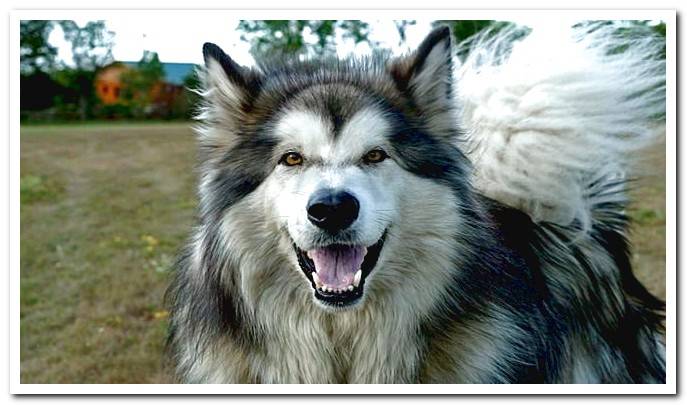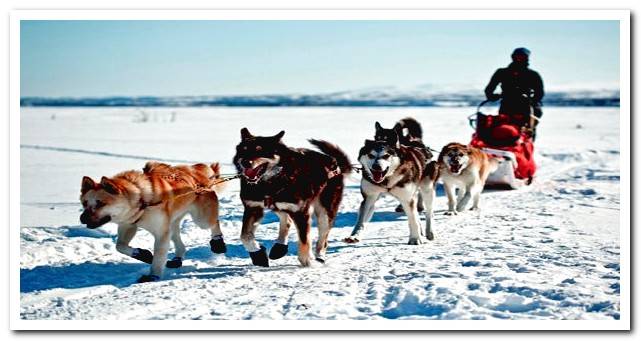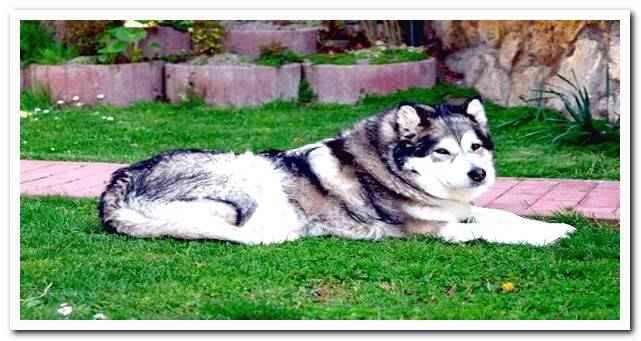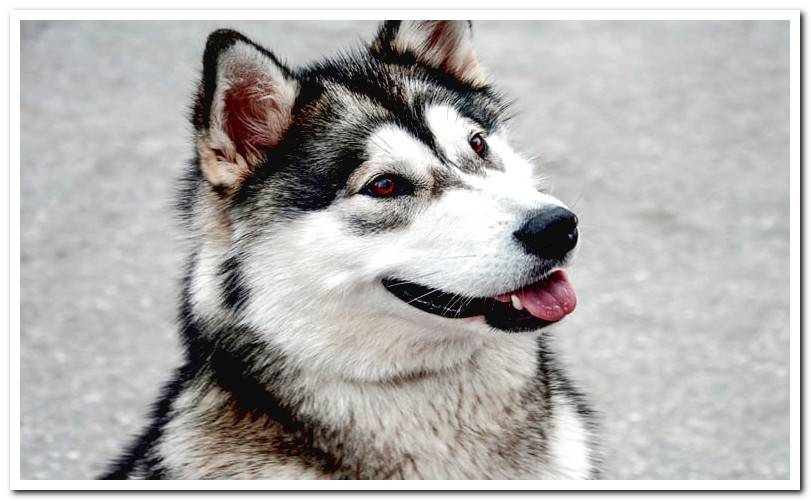
If you are thinking of sharing your life with an Alaskan Malamute, it would be interesting for you to first inform yourself thoroughly about all the details of the race.
From Dogsis we have wanted to collect all this information so that people like you can enjoy it. If you have any questions, leave it in the comments and we will help you solve it.
Index of contents
- 1 Alaskan Malamute dog breed data sheet
- 2 Physical characteristics of the Alaskan Malamute breed
- 3 How is the behavior of an Alaskan Malamute dog?
- 4 Recommended care for the Alaskan Malamute dog breed
- 5 Possible diseases in the Alaskan Malamute dog breed
- 6 Alaskan Malamute breed history
Alaskan Malamute dog breed data sheet
|
|
Height between 58 and 71cm in males and between 58 and 65cm in females |
|
|
Weight of between 35 and 50 kg for males and between 30 and 40 kg for females |
|
|
Long, fine and very abundant hair. Gray, black, earth or white |
|
|
Loving, playful, intelligent and very active character |
|
|
Strong health although prone to heat stroke |
|
|
Estimated life expectancy between 10 and 13 years |

Physical characteristics of the Alaskan Malamute breed

In the Alaskan Malamute breed we can find considerable weight oscillations, with specimens that barely reach 40 kg and others that are well above 50.
The females they are smaller than males. Its standard height is between 58 and 71 cm.
Regarding its morphological characteristics, of wolf aspect, we highlight the following:
- Almond-shaped eyes , very expressive and brown in color, although they may be clear in red specimens.
- Ears , triangular and rounded at the tip, they are small compared to their body. This reduces heat loss and the risk of freezing.
- The body he is muscular and strong, which gives him a powerful aspect, with a deep chest, prepared for the drag of weights. It is longer than it is tall.
- The tail it is densely packed with hair and curls itself up on top of the rump.
- The mantle it is black and white, red or gray. It can also be completely white. It is very dense, prepared for the coldest temperatures.
It is provided with a fleecy inner layer, insulating and waterproof. The outer layer is also characterized by its density. Between the fingers it has a thick coat that serves to protect itself from the ice, common in its regions of origin.
It’s a dog stronger than fast, so it is capable of traveling long distances. It has a life expectancy of about 12 years.
How is the behavior of an Alaskan Malamute dog?
Despite what it may seem from its size and its wolf aspect, it is a loving and playful dog. Although he does not show it in excess, he will play with full confidence and disinhibition with the family and the people or dogs he knows.
It is also good with children but we must always watch it, since it could throw them due to its large dimensions. So it can be said that he’s a reserved dog until he feels confident.
Of course, its management is not always easy, because it is stubborn, and it may require a professional education with veterinaryns specialized in behavior, ethologists or accredited canine educators.
You can easily learn because it is a very smart dog. With cats or other small animals we must be careful because they could identify them as prey, coming to attack them.
They usually like howling, not barking, and digging. If their basic needs are not met, they can express it through destructive behaviors.
To avoid socialization problems as much as possible, if we are going to adopt a puppy it is better that we do not do it before 8-10 weeks of life, since it is very important that this stage is spent learning with its mother and / or siblings.
Some specimens, especially males, can be dominant and even aggressive, hence the importance of proper education. It is recommended the castration to reduce these behaviors.
Not only do you need exercise, but challenges on a mental level to keep busy. Despite its imposing appearance and size, it is not a watchdog and can relate warmly to strangers.
In general, providing it with the activity it needs, it is a calm animal that could get used to living in an apartment in the city, as long as it has the possibility of doing the exercise that is essential for it.
It is listed as a sled dog. Not a dog for inexperienced caretakers.

Recommended care for the Alaskan Malamute dog breed

According to its origins, it is a dog with ease to be able to live outside, as it withstands su
b-zero temperatures. You can be more comfortable in houses and farms than in urban settings.
Also, it is a breed with a high need for exercise, since it has great energy, a very important aspect to take into account if we want to live with an Alaskan, since we must have time to walk it or safe spaces where to release it, even if it lives abroad.
An Alaskan permanently locked up in a farm, even if it is large, is going to get bored and it is easy to try to escape, with the danger that this implies.
Regular brushing is convenient for its very dense coat, especially during moulting periods to facilitate hair loss. Being so thick we will have to make sure we reach its base.
Brushing with the tools recommended by our veterinaryn or canine groomer avoids the formation of knots and keeps the coat clean, which will reduce the need to bathe it.
If we do we have to make sure that we leave the hair completely rinsed, since the shampoo remains could cause skin irritation.
You also have to dry it completely, which will take time, so there are caregivers who prefer to bathe them in dog grooming salons, where they have more powerful dryers than those used in homes. This type of cloak should not be cut, even in summer.
Possible diseases in the Alaskan Malamute dog breed
Due to its characteristics oriented to life in the snow it is a breed prone to suffer heat stroke, a veterinary emergency that occurs due to the elevation of body temperature and that can result in shock and even death.
For this reason, we must provide it with cool environments in which to take shelter in the warmer months, and we must never leave them locked in the sun, even for a few minutes.
Nor should we allow them to exercise when temperatures are high. Alaskan Malamute tend to suffer from disorders such as the following:
- Hip dysplasia: As large dogs, they are more prone to this dysplasia in which the head of the femur does not fit well on the hip, causing pain and lameness. It is diagnosed through x-rays and, depending on the grade, may require surgery.
- Elbow dysplasia: Although it occurs to a lesser extent, this dysplasia prevents the bones of the front leg from fitting together, resulting in pain, lameness and inflammation of the area. It can be seen on radiographs. The therapeutic choice is usually surgical.
- Glaucoma: severe eye disease due to increased intraocular pressure. It produces pain, which leads to the dog rubbing its eye with its paws. We will notice the opaque cornea and the enlarged pupil. Requires prompt veterinary assistance as vision may be lost.
- Retinal atrophy: It is an inherited disease that consists of degeneration of the retina. The affected dog begins to have trouble seeing in hours or low light spaces. Then the sight ends up always failing him. The dilated pupils and the opaque eyes can be observed, as if they had a cloud. It is cause of blindness.
- Hypothyroidism: disorder of the thyroid gland in which it does not produce enough hormones and that manifests itself in problems in the skin and hair, in addition to changes in weight or intolerance to cold. The vet can detect it in a blood test, since it must be distinguished from diseases with similar symptoms. You have drug treatment.
- Zinc deficiency: translated into skin problems and hair loss. Relatively common in this breed and in similar ones. It presents with crusts on the face, truffle and around the eyes, ears and mouth, and also at pressure points such as the elbows. Also, calluses appear on the feet that crack.
In the Alaskan, a genetic defect has been identified that affects zinc absorption, so the deficiency does not have to be due to inadequate nutrition. Treatment usually consists of supplementing this trace element for life.
Finally, we must provide our Alaskan with quality food that is adequate to their needs to avoid being overweight and the risks that this entails.
In addition, due to its size, it is at risk of stomach torsion, a serious problem that occurs when the stomach turns on itself, being obstructed for the entry and exit of liquids and gases.
Without veterinary attention it can cause death. It is prevented by preventing you from eating or drinking large amounts at once or after vigorous exercise. The daily dose should be divided into 2-3 servings a day.

Alaskan Malamute breed history
The origins of the Alaskan Malamute date back to ancient times and are found in the United States, where it remains a very popular breed, just like in Canada.
Thousands of years ago, dogs of this type were descendants of those who had moved to arctic regions, where crossed with wolves traveling from the tundra southward, seeking areas of milder climates.
The Alaskan Malamute was held throughout the Arctic region. It was a dog that was used to pull sleds, for transport, to carry food and other supplies, but also for hunting seals and even bears.
In our day, it has become a companion dog, although the breed continues to pull sleds and participate in races. These sled dog competitions started in Alaska in the late 1800s and are very popular today in North America and throughout northern Europe.
Alaskan Malamute were used in them although they were soon imported Siberian Huskies that, more athletic, began to prevail in the races due to the higher speed they are able to reach.
The name of Alaskan Malamute comes from the village Inuit Mahlemut who lived on the arctic coast of western Alaska. The Alaskan was used as a draft animal long before the Europeans arrived in America.
These dogs helped human groups in these regions survive, becoming essential allies. His charisma has reached literature thanks to well-known authors such as Jack London.
